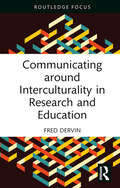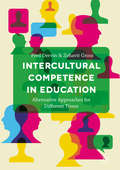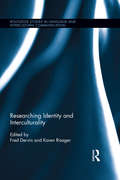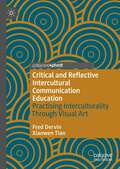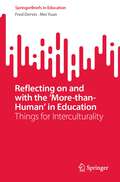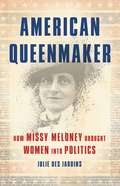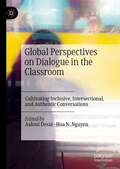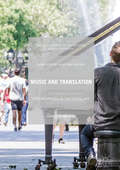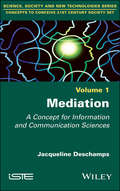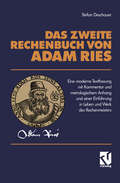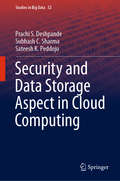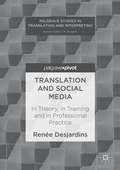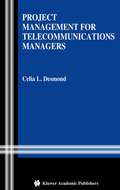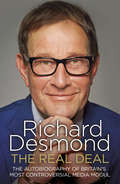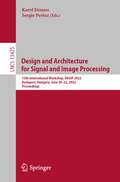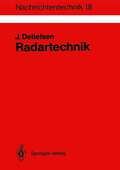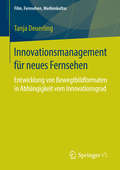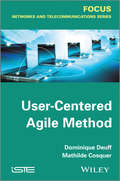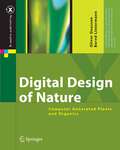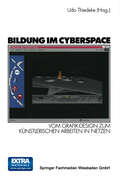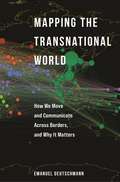- Table View
- List View
Communicating around Interculturality in Research and Education (New Perspectives on Teaching Interculturality)
by Fred DervinThis book does not instruct the reader how to communicate interculturally but supports them in reflecting on how they can (re-)negotiate and (re-)construct knowledge(s), ideologies and relations around the notion of interculturality. Anchored in the author’s original and thought-provoking perspectives on interculturality, this interdisciplinary and global-minded book explores how communicating around the notion cannot do away with ideologisms, issues of language and translation or the problematization of voice and silence in research and education. Written in an original and stimulating way, relying on different writing genres and styles to ‘mimic’ the dynamism and flexibility of the very notion under review, the author urges us to (un-)voice, scrutinize, nurture and galvanize our ways of dealing with interculturality alone and together with others in academia. The very specific focus of the book, communicating around interculturality (instead of ‘doing’ interculturality), represents a fresh and important move for observing, analyzing, speaking of and contributing to today's complex and divided world. The title is aimed at researchers, students and educators interested in examining and enriching their own takes on interculturality, from a more reflexive and interactive perspective.
Intercultural Competence in Education: Alternative Approaches for Different Times
by Fred Dervin Zehavit GrossThis book explores the concept of intercultural competence, focusing specifically on education. Intercultural competence can vary depending on the field of research or the context of application and has therefore developed over recent decades. As the world becomes increasingly global intercultural competence has become even more important but it is still not practiced satisfactorily. This book highlights views which are at odds with official and orthodox positions on intercultural competence to encourage fresh approaches to intercultural competence. It will be invaluable for researchers, practitioners and students interested in the global possibilities of education.
Researching Identity and Interculturality (Routledge Studies in Language and Intercultural Communication #3)
by Fred Dervin Karen RisagerThis volume focuses on advances in research methodology in an interdisciplinary field framed by discourses of identity and interculturality. It includes a range of qualitative studies: studies of interaction, narrative studies, conversation analysis, ethnographic studies, postcolonial studies and critical discourse studies, and emphasizes the role of discourse and power in all studies of identity and interculturality. The volume particularly focuses on critical reflexivity in every stage of research, including reflections on theoretical concepts (such as ‘identity’ and ‘interculturality’) and their relationship with methodology and analytical practice, reflections on researcher identity and subjectivity, reflections on local and global contexts of research, and reflections on language choice and linguacultural aspects of data generation, analysis and communication.
Researching Identity and Interculturality (Routledge Studies in Language and Intercultural Communication)
by Fred Dervin Karen RisagerThis volume focuses on advances in research methodology in an interdisciplinary field framed by discourses of identity and interculturality. It includes a range of qualitative studies: studies of interaction, narrative studies, conversation analysis, ethnographic studies, postcolonial studies and critical discourse studies, and emphasizes the role of discourse and power in all studies of identity and interculturality. The volume particularly focuses on critical reflexivity in every stage of research, including reflections on theoretical concepts (such as ‘identity’ and ‘interculturality’) and their relationship with methodology and analytical practice, reflections on researcher identity and subjectivity, reflections on local and global contexts of research, and reflections on language choice and linguacultural aspects of data generation, analysis and communication.
Critical and Reflective Intercultural Communication Education: Practicing Interculturality Through Visual Art
by Fred Dervin Xiaowen TianThis book provides answers to the following questions: How could visual art support us in reflecting about interculturality critically? When we look at, engage with and experience art, what is it that we can learn, unlearn and relearn about interculturality? The book adds to the multifaceted and multidisciplinary field of intercultural communication education by urging those working on the notion of interculturality (researchers, scholars and students) to give art a place in exploring its complexities. No knowledge background about art (theory) is needed to work through the chapters. The book helps us reflect on ourselves and on our engagement with the world and with others, and learn to ask questions about these elements. The authors draw on anthropology, linguistics, philosophy and sociology to enrich their discussions of critical interculturality.
Reflecting on and with the ‘More-than-Human’ in Education: Things for Interculturality (SpringerBriefs in Education)
by Fred Dervin Mei YuanThis book examines today’s central and yet often misunderstood and misconstrued notion of interculturality. It specifically focuses on one aspect of intercultural awareness that has been ignored in research and education: the presence and influence of things on the way we experience, do, and reflect on interculturality. This book provides the readers with opportunities to engage with interculturality by reflecting on how our lives are full of things and entangled with them. It urges teachers, teacher educators, scholars, and students to open their eyes to the richness that the more-than-human, with which we can reflect, has to offer for intercultural communication education.
American Queenmaker: How Missy Meloney Brought Women Into Politics
by Julie Des JardinsThe first biography of Missy Meloney, the most important woman you've never heard of Marie "Missy" Mattingly Meloney was born in 1878, in an America where women couldn't vote. Yet she recognized the power that women held as consumers and family decision-makers, and persuaded male publishers and politicians to take them seriously. Over the course of her life as a journalist, magazine editor-in-chief, and political advisor, Missy created the idea of the female demographic. After the passage of the 19th Amendment she encouraged candidates to engage with and appeal to women directly. In this role, she advised Presidents from Hoover and Coolidge to FDR. By the time she died in 1943, women were a recognized political force to be reckoned with.In this groundbreaking biography, historian Julie Des Jardins restores Missy to her rightful place in American history.
Global Perspectives on Dialogue in the Classroom: Cultivating Inclusive, Intersectional, and Authentic Conversations
by Ashmi Desai Hoa N. NguyenThis book explores globally-informed, culturally-rooted approaches to dialogue in the classroom. It seeks to fill gaps in communication and education literature related to decolonizing dialogue and breaking binaries by decentering Eurocentric perspectives and providing space for dialogic practices grounded in cultural wealth of students and teachers. We first describe the book’s genesis, contextualize dialogue within the global impact of the COVID-19 pandemic, and share guiding concepts of inclusion, intersectionality, and authenticity in dialogue and pedagogy. We also distinguish dialogue from other practices and times in which dialogue may not be possible. The book brings fresh and urgent perspectives from authors across different disciplines, including ceramics, religious studies, cultural studies, communication, family therapy, and conflict resolution. The chapters distill the idea of dialogue within contexts like a bible circle, university sculpture studio, trauma and peacebuilding program, and connect dialogue to teaching, learning, and emerging ideas of power disruption, in-betweenness, and relationality.
Music and Translation: New Mediations in the Digital Age (Palgrave Studies in Translating and Interpreting)
by Lucile DesblacheThis book explores how transformations and translations shape musical meanings, developments and the perception of music across cultures. Starting with the concept of music as multimodal text, the author understands translation as the process of transferring a text from one language – verbal or not – into another, interlingually, intralingually or intersemiotically, as well as the products that are derived from this process. She situates music and translation within their contemporary global context, examining the tensions between local and global, cosmopolitan and national, and universal and specific settings, to arrive at a celebration of the translational power of music and an in-depth study of how musical texts are translated. This book will be of interest to translation studies scholars who want to broaden their horizons, as well as to musicians and music scholars seeking to understand how cultural exchange and dissemination can be driven by translation.
Mediation: A Concept for Information and Communication Sciences
by Jacqueline DeschampsMediation is a very old practice that has been reborn to meet the needs of the contemporary world. It is thus increasingly present in today's societies. This book presents the theoretical foundations of mediation, as well as the way in which teachers and researchers in Information and Communication Sciences (ICS) have taken up this concept. Whether it is communicational, informational, cultural, organizational or societal, mediation belongs to a field of research, instituted by ICS, which sees in it a process of overcoming conflict, restoring communication and deconstructing social connections. Mediation: A Concept for Information and Communication Sciences inaugurates this set through its contribution to a state of the art of the theory and concepts used by the ICS community. It is addressed to teachers, researchers and students, as well as information professionals wishing to think about their daily practice.
Mediation: A Concept for Information and Communication Sciences
by Jacqueline DeschampsMediation is a very old practice that has been reborn to meet the needs of the contemporary world. It is thus increasingly present in today's societies. This book presents the theoretical foundations of mediation, as well as the way in which teachers and researchers in Information and Communication Sciences (ICS) have taken up this concept. Whether it is communicational, informational, cultural, organizational or societal, mediation belongs to a field of research, instituted by ICS, which sees in it a process of overcoming conflict, restoring communication and deconstructing social connections. Mediation: A Concept for Information and Communication Sciences inaugurates this set through its contribution to a state of the art of the theory and concepts used by the ICS community. It is addressed to teachers, researchers and students, as well as information professionals wishing to think about their daily practice.
Das Zweite Rechenbuch Von Adam Ries: Eine moderne Textfassung mit Kommentar und metrologischem Anhang und einer Einführung in Leben und Werk des Rechenmeisters
by Stefan DeschauerSecurity and Data Storage Aspect in Cloud Computing (Studies in Big Data #52)
by Prachi S. Deshpande Subhash C. Sharma Sateesh K. PeddojuThis book analyses the various security threats in cloud computing. A host-based IDS (HIDS) using signature verification is developed and implemented for the concerned security issues. Further, owing to the vulnerability of distributed denial of service (DDoS) attacks in cloud computing, a network based IDS (NIDS) is developed and implemented against such attacks. The performance of these IDS is verified in the Cloud scenario as well against the standard data set. Finally, a simple data storage and security model is developed and implemented for the Cloud computing scenario. The contents of this book will be of interest to researchers and professionals alike.
Translation and Social Media: In Theory, in Training and in Professional Practice (Palgrave Studies in Translating and Interpreting)
by Renée DesjardinsOffering a discussion of translation and social media through three themes, theory, training and professional practice, this book builds on emerging research in Translation Studies, including references citing recent translation and social media industry data. Topics include the translation of hashtags and the relevance of indexing, among others.
Project Management for Telecommunications Managers
by Celia L. DesmondThis concise reference covers important aspects of project management. It explains many key concepts in layman's terms, provides tools for planning, organizing, tracking and managing projects and gives examples of various telecommunications projects from wireline and wireless providers, equipment vendors and component manufacturers.
The Real Deal: The Autobiography of Britain’s Most Controversial Media Mogul
by Richard DesmondFrom the age of five, when he helped his deaf father negotiate advertising contracts, Richard Desmond has always had an eye for business. In The Real Deal he offers a no-holds-barred account of an extraordinary career that has taken him from cloakroom attendant at a north London club to billionaire media owner. En route he tells of his early life as a rock and roll drummer, his first steps in the world of magazine publishing as a purveyor of leisure and top-shelf titles, and finally, after decades of paying his dues building smaller brands, his arrival in the big league with the launch of OK! magazine and the acquisition of Express Newspapers, his purchase and sale of Channel 5, and his £80 million investment in the Health Lottery, combining business innovation with help for good causes. Along the way, he imparts many of the secrets of his astounding success, as well as giving his forthright opinion (and he always has one) on such diverse subjects as politicians, religion, and the similarities between being a rock and roll drummer and running a business – as well as his views on a cast of characters ranging from Alan Sugar to Victoria Beckham and from Simon Cowell to Jennifer Aniston.Often controversial, frequently revelatory, always entertaining, The Real Deal is the brilliantly frank account of a life spent at the sharp end.
Design and Architecture for Signal and Image Processing: 15th International Workshop, DASIP 2022, Budapest, Hungary, June 20–22, 2022, Proceedings (Lecture Notes in Computer Science #13425)
by Karol Desnos Sergio PertuzThis book constitutes the thoroughly refereed conference proceedings of the First International Workshop on Design and Architecture for Signal and Image Processing, DASIP 2022, held in Budaypest, Hungary in June 2022. The 13 full included in the volume were carefully reviewed and selected from 32 submissions. They are organized in the following topical sections: leading signal, image and video processing and machine learning in custom embedded, edge and cloud computing architectures and systems.
Radartechnik: Grundlagen, Bauelemente, Verfahren, Anwendungen (Nachrichtentechnik #18)
by Jürgen DetlefsenInnovationsmanagement für neues Fernsehen: Entwicklung von Bewegtbildformaten in Abhängigkeit vom Innovationsgrad (Film, Fernsehen, Medienkultur)
by Tanja DeuerlingTanja Deuerling zeigt, wie die Entwicklung von Bewegtbildformaten im Spannungsfeld zwischen Kreativität und Management in jeder einzelnen Phase des Innovationsprozesses zielgerichtet gesteuert werden kann. Mit ihrem „Grad-Phasen-Modell“ lässt sich die Formatentwicklung in Abhängigkeit vom Innovationsgrad analysieren, strukturieren und managen: Je nachdem, wie innovativ ein Produkt des „neuen Fernsehens“ sein soll, verändern sich die Anforderungen an Organisation, Akteure und Prozesssteuerung. Das Buch liefert damit auf Basis von Erkenntnissen aus der Medienwissenschaft und -ökonomie sowie aus der Innovations- und Kreativitätsforschung einen handlungsorientierten Theorierahmen für die Medienproduktion sowie konkrete Empfehlungen zum Management von Bewegtbildinnovationen.
User-Centered Agile Method
by Dominique Deuff Mathilde CosquerAgile development methods began to emerge around 20 years ago. However, it was not until the early 2000s that they began to be widely used in industry. This growth was often due to the advent of Internet services requiring faster cycles of development in order to heighten the rate at which an ever-greater number of functionalities were made available. In parallel, user-centered design (UCD) methods were also becoming more and more widely used: hence, user-centered design and agile methods were bound to cross paths, at least in the telecoms industry! During this period, in the field of telecommunications, the explosion in the number of connected terminals, Web applications, new use environments (particularly in a domestic setting), etc., meant it was crucial to gain a fuller understanding of users’ requirements and better evaluate the relevance and acceptance of services’ attempts to cater for these requirements. Thus the user-centered agile method, as proposed in this book, aims to mutually integrate two existing methods: user-centered design – as used by ergonomists – and the agile Scrum method – as used by developers. The user testing method is also covered. Analyzing work on this subject spanning the past 10 years, the authors also provide an assessment of the feedback on the user-centered agile method. The method described in this book has been based on all these sources. It is a framework relying on the logic introduced by Scrum, i.e. a framework based on project management. The method proposed is seen as an extension of Scrum which is “centered on humans” because of the integration of user-centered design and user-testing. Therefore the description of the user-centered agile method is based on the basics of the agile Scrum method and uses its terminology and elements. As well as descriptive elements of the user-centered agile method, practical examples of how to implement it are also provided. Contents 1. Introduction. 2. Intrioduction to the Methods Employed. 3. Sources for this Work. 4. Description of The User-Centered Agile Method. 5. Case Studies. About the Authors Dominique Deuff worked at the National Institute of Informatics in Japan for 2½ years before coming back to France in June 2006 and joining Orange Labs France Telecom as a developer in a Scrum team. In 2008, she graduated with a Master’s degree in ergonomics and has since then been applying her new skills to various projects at Orange Labs Lannion. Mathilde Cosquer joined Orange Labs as an ergonomist after completing her PhD on the question of transparency of technical devices from the user’s point of view. She has taken part in the design and evaluation of numerous innovating services, but over the past four years, she has been more particularly involved in projects of interpersonal communication services.
User-Centered Agile Method
by Dominique Deuff Mathilde CosquerAgile development methods began to emerge around 20 years ago. However, it was not until the early 2000s that they began to be widely used in industry. This growth was often due to the advent of Internet services requiring faster cycles of development in order to heighten the rate at which an ever-greater number of functionalities were made available. In parallel, user-centered design (UCD) methods were also becoming more and more widely used: hence, user-centered design and agile methods were bound to cross paths, at least in the telecoms industry! During this period, in the field of telecommunications, the explosion in the number of connected terminals, Web applications, new use environments (particularly in a domestic setting), etc., meant it was crucial to gain a fuller understanding of users’ requirements and better evaluate the relevance and acceptance of services’ attempts to cater for these requirements. Thus the user-centered agile method, as proposed in this book, aims to mutually integrate two existing methods: user-centered design – as used by ergonomists – and the agile Scrum method – as used by developers. The user testing method is also covered. Analyzing work on this subject spanning the past 10 years, the authors also provide an assessment of the feedback on the user-centered agile method. The method described in this book has been based on all these sources. It is a framework relying on the logic introduced by Scrum, i.e. a framework based on project management. The method proposed is seen as an extension of Scrum which is “centered on humans” because of the integration of user-centered design and user-testing. Therefore the description of the user-centered agile method is based on the basics of the agile Scrum method and uses its terminology and elements. As well as descriptive elements of the user-centered agile method, practical examples of how to implement it are also provided. Contents 1. Introduction. 2. Intrioduction to the Methods Employed. 3. Sources for this Work. 4. Description of The User-Centered Agile Method. 5. Case Studies. About the Authors Dominique Deuff worked at the National Institute of Informatics in Japan for 2½ years before coming back to France in June 2006 and joining Orange Labs France Telecom as a developer in a Scrum team. In 2008, she graduated with a Master’s degree in ergonomics and has since then been applying her new skills to various projects at Orange Labs Lannion. Mathilde Cosquer joined Orange Labs as an ergonomist after completing her PhD on the question of transparency of technical devices from the user’s point of view. She has taken part in the design and evaluation of numerous innovating services, but over the past four years, she has been more particularly involved in projects of interpersonal communication services.
Digital Design of Nature: Computer Generated Plants and Organics (X.media.publishing)
by Oliver Deussen Bernd LintermannWhat is computer graphics and what are the conceptual tasks of research in this area? To the average person the term still conveys more or less the design of - gos and the manipulation of pictures with the help of image-editing programs. However, during the past four decades, computer graphics has evolved into an innovative multifaceted ?eld of research and computing that affects many other sciences. In many areas and for many problems we can best convey an und- standing through images that trigger our sense with the highest capability: our eye. And, what is more, aside from algorithms, formulas, and tables, the c- puter graphics scientist often is able to create beauty. Though it is a beauty of its own, it often fascinates the viewer, especially when complex aesthetic images emerge from simple mathematical concepts. Also, there are only a few other areas that advance as dynamically as inf- matics and especially computer graphics. While CPU capacity still increases and is almost doubled every 18 months, the rendering speed and ef?ciency of graphics boards has increased even more during recent years. Today, images can be rendered in real time that some years ago still required several hours of computing. Parallel to the rapid improvement of computer hardware, many newalgorithms weredevelopedthattoday form the basis for some fundamental changes and achievements in graphics.
Bildung im Cyberspace: Vom Grafik-Design zum künstlerischen Arbeiten in Netzen. Entwicklung und Erprobung eines Weiterbildungskonzeptes. Projektband 1
by Deutsches Inst. f. ErwachsenenbildungDie Verbreitung "neuer", computergestützter Medien verändert das Potenzial, Wissen zu erwerben und zu kommunizieren. So kann im Internet Bildungswissen individuell und außerhalb etablierter Bildungsinstitutionen erworben werden. Zugleich bietet sich den Nutzern die Möglichkeit, als Medienproduzenten selbstgestalteter Inhalte aufzutreten. Hierzu sind jedoch technische und kulturelle Kompetenzen im Umgang mit den neuen Medien Voraussetzung. Der vorliegende Band beleuchtet die Problematik kreativer Medienkompetenz als Grundlage einer erweiterten Bildung aus interdisziplinären Blickwinkeln und mit empirischem Bezug zu einem Modellprojekt der kulturellen Bildung, das von Bundesministerium für Wissenschaft, Forschung und Technologie unterstützt und vom Deutschen Institut für Erwachsenenbildung e.V. in Kooperation mit dem Institut für Neue Medien sowie verschiedenen Bildungseinrichtungen durchgeführt wurde.
Mapping the Transnational World: How We Move and Communicate across Borders, and Why It Matters (Princeton Studies in Global and Comparative Sociology)
by Emanuel DeutschmannA study of the structure, growth, and future of transnational human travel and communicationIncreasingly, people travel and communicate across borders. Yet, we still know little about the overall structure of this transnational world. Is it really a fully globalized world in which everything is linked, as popular catchphrases like “global village” suggest? Through a sweeping comparative analysis of eight types of mobility and communication among countries worldwide—from migration and tourism to Facebook friendships and phone calls—Mapping the Transnational World demonstrates that our behavior is actually regionalized, not globalized.Emanuel Deutschmann shows that transnational activity within world regions is not so much the outcome of political, cultural, or economic factors, but is driven primarily by geographic distance. He explains that the spatial structure of transnational human activity follows a simple mathematical function, the power law, a pattern that also fits the movements of many other animal species on the planet. Moreover, this pattern remained extremely stable during the five decades studied—1960 to 2010. Unveiling proximity-induced regionalism as a major feature of planet-scale networks of transnational human activity, Deutschmann provides a crucial corrective to several fields of research.Revealing why a truly global society is unlikely to emerge, Mapping the Transnational World highlights the essential role of interaction beyond borders on a planet that remains spatially fragmented.
Mapping the Transnational World: How We Move and Communicate across Borders, and Why It Matters (Princeton Studies in Global and Comparative Sociology)
by Emanuel DeutschmannA study of the structure, growth, and future of transnational human travel and communicationIncreasingly, people travel and communicate across borders. Yet, we still know little about the overall structure of this transnational world. Is it really a fully globalized world in which everything is linked, as popular catchphrases like “global village” suggest? Through a sweeping comparative analysis of eight types of mobility and communication among countries worldwide—from migration and tourism to Facebook friendships and phone calls—Mapping the Transnational World demonstrates that our behavior is actually regionalized, not globalized.Emanuel Deutschmann shows that transnational activity within world regions is not so much the outcome of political, cultural, or economic factors, but is driven primarily by geographic distance. He explains that the spatial structure of transnational human activity follows a simple mathematical function, the power law, a pattern that also fits the movements of many other animal species on the planet. Moreover, this pattern remained extremely stable during the five decades studied—1960 to 2010. Unveiling proximity-induced regionalism as a major feature of planet-scale networks of transnational human activity, Deutschmann provides a crucial corrective to several fields of research.Revealing why a truly global society is unlikely to emerge, Mapping the Transnational World highlights the essential role of interaction beyond borders on a planet that remains spatially fragmented.
